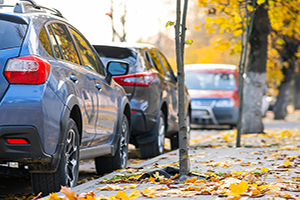Downtown: Part I - A Plan for Curb Appeal
Did you know that 70% of first-time retail sales come from curb appeal? It’s the number one thing retailers and restaurants can do to attract traffic, especially to downtown. That matters to cities because the more successful businesses are, the more tax revenue they generate, and the more visitors they attract to the city.
There are relatively simple things cities can do to make downtowns pop. For instance, here’s a tip. For flowers, the most vibrant colors are red and yellow. It’s the small (not necessarily costly) details that make a difference.
In a recent webinar, Roger Brooks of Destination Development Association (DDA) outlined city considerations to help downtowns become destinations for locals and residents alike. Brooks has been a popular speaker at past KLC conferences and has worked in more than 2,000 cities worldwide on downtown development.
Plan and Commit

Brooks said that if you want a thriving downtown, the most important public-private partnerships a city can have are with merchants and merchant associations. Once your city has agreed to be part of the big picture, see what others are already doing. Discuss ideas with merchants, your local chamber, Main Street programs and downtown business owners. Get buy-in from your city council/commission. Talk with your Parks & Recreation staff because they may be involved in any type of downtown maintenance. Work with garden clubs and any other types of groups interested in the success of your downtown. Convene interested parties and organize a plan for beautification. If a merchant’s association, Main Street group or Chamber is already doing this, support it. The city doesn’t necessarily need to drive the effort but if it agrees to be part of it, there has to be a commitment. Maintenance is by far the biggest and most important part of any beautification effort. There’s nothing worse than driving thrown a downtown filled with dying flowers. So, join or start an effort - and commit.
Sidewalks, Streets and Parking

Brooks said that successful thriving downtowns have three things: Wide sidewalks, centralized parking and two-way streets. These infrastructure decisions are functions and decisions of the city.
Wider sidewalks allow for benches, planters, greenspaces and landscaping, as well as tables and chairs for cafes and restaurants. Now more than ever, diners want to dine outside. Families want to stroll the kids, walk the dog and eat ice cream outside. People want to sit outside while others in their group are shopping. Any or all of these activities require adequate sidewalk space. It’s a big decision to widen sidewalks along main streets but it changes the dynamic of a downtown. While widening public sidewalks is an expense, consider grants. KLC’s Member & Business Development team can discuss what may be available for specific projects.
It stands to reason that if a city widens its sidewalks, some of its street parking will be reduced. Contrary to popular belief, store front parking is not imperative. Brooks said parking formulas are long gone and cities everywhere are getting rid of street parking. Cities or local merchant groups are creating shared parking lots where patrons can park and walk to the downtown businesses. Parking a block or two away is not an issue for tourists strolling around, nor is it a big deal for most local people today. Brooks said this is an important mind shift. For lively downtowns to have shops, boutiques and restaurants, parking is not the draw. Sidewalks with café tables, benches, flowers and trees, and appealing streetscapes are the draw.
One final thought on parking. The average person shopping at a Wal-Mart parks 340 feet away from the front door – approximately one block. Parking is not what brings people downtown. Brooks also said one-way streets were recommended by planners decades ago but are no longer. They are confusing for visitors and often take more time to get around.
Strategies and Partners

All of us have chosen places to stop simply based on its outward appearance. There are simply steps to begin an organized beautification strategy. The important thing to remember is that there are professionals in your city with experience in making spaces come alive including landscapers, interior designers, architects, florists, gardeners, artists or others. Also, especially for smaller cities, less is more in terms of diversity of design. Ideally, one organization should oversee the downtown’s appearance direction. While each business should embrace its own appeal, some communities have successfully created downtown co-op or nonprofit downtown association models. Your Main Street or chamber may take it on, or even a garden club. This keeps all downtown merchants on the same page in terms of quality expectation and helps with resources. Nonprofits can also apply for many grants and accept donations of materials such as pots, benches and more.
There are good examples of cities doing a great job of Beautification in Kentucky including the cities of Scottsville, Campbellsville, Pineville, and many more. Brooks also cites the City of Fredericksburg, Texas as one doing a lot on small budget.
Brooks said typically merchants are willing to contribute an annual fee and are relieved when someone else takes on the job of purchasing and keeping plants watered and benches painted.
Once the strategy and plan are in place, there are details to the beautification and maintenance. Those include trees; pots, planters and window boxes; benches, tables and chairs; exterior displays; and attractive awning and blade/shingle signs. Another blog looks at each of these in detail, as well as the use of volunteers to help with maintenance. The city’s role could be one of infrastructure and maintenance. If it’s more than that, consider the time it will take your city staff. A handful of committed retailers or restauranteurs can’t carry the load. For a thriving downtown, the city must be involved. Brooks said with a healthy mix of businesses and eateries and some strategic beautification efforts, sales could double in your downtown, which will in turn lead to more businesses and increase your tax base.
While there are many ways to approach downtown beautification, thinking about goals and your long-term strategy for the core of your city is the place to begin. Is your downtown a revenue source? Why or why not? Are you proud of the way it looks? How do you envision it in the future?
Curb appeal is the most important reason someone makes a stop. Do people stop in your city’s downtown, or do they drive right through on their way to someplace else? That is the crucial question.


